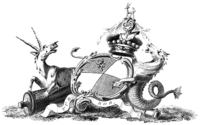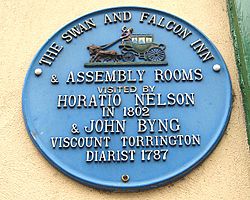John Byng, 5th Viscount Torrington facts for kids
Quick facts for kids
John Byng,
5th Viscount Torrington |
|
|---|---|

Byng arms: Quarterly sable and argent in the first quarter a lion rampant of the second
|
|
| Born | 18 February 1743 Southill, Bedfordshire
|
| Died | 8 January 1813 London, United Kingdom
|
| Other names | The Hon. John Byng |
| Education | Westminster |
| Occupation | Army officer and civil servant |
| Known for | Travel journals |
| Title | Viscount Torrington; Baron Byng; Baronet, of Wrotham |
| Political party | Whig |
| Spouse(s) | Bridget Forrest (d. 1823) |
| Relatives | Earls of Strafford |
John Byng, 5th Viscount Torrington (born February 18, 1743 – died January 8, 1813) was a British nobleman. For most of his life, he was known as The Hon. John Byng. He became famous for the detailed diaries he wrote in the late 1700s.
Byng's fifteen diaries, written between 1781 and 1794, describe his many trips. He traveled on horseback across England and Wales during twelve summers. These diaries give us a great look into what life was like back then.
Contents
Byng's Family History
John Byng was the younger son of Major-General George Byng, 3rd Viscount Torrington. His grandfather, Admiral Sir George Byng, was made a baronet in 1715. Later, he became Viscount Torrington in 1721.
The Byng family used to live at Southill Park in Bedfordshire. John Byng was also a great-uncle to the important politician Lord John Russell.
John Byng's Life Story
John Byng went to Westminster School when he was younger. After school, he joined the Grenadier Guards, a famous army regiment. He retired from the army in 1780 as a Colonel.
On December 14, 1812, John Byng became the 5th Viscount Torrington. He inherited this title after his older brother, George Byng, 4th Viscount Torrington, passed away. Sadly, John Byng died soon after, in 1813, before he could officially join the House of Lords.
His older brother had sold their family home, Southill Park, to pay off debts. This meant that John Byng became a Viscount but no longer owned the family lands.
Marriage and Children
On March 3, 1767, John Byng married Bridget Forrest. Her father was Commodore Arthur Forrest of the Royal Navy.
Lord and Lady Torrington had 14 children together. Thirteen of their children lived past infancy.
Byng's Sons
- George Byng, 6th Viscount Torrington (1768–1831) was their oldest son and heir. He became the 6th Viscount Torrington and joined the House of Lords in 1813.
- The Hon. Edmund John Byng (1774–1854) worked as a Commissioner in the Colonial Audit Office.
- The Hon. John Byng (1777–1811).
- The Hon. Henry Dilkes Byng (1781–1860) became a Vice-Admiral in the Royal Navy.
- The Hon. Frederick Gerald Finch Byng (1784–1871) was known as Poodle Byng. He was a fashionable man during the Regency era. He worked for George, Prince of Wales, served in the British Army, and later in the Foreign Office. He also worked to improve sanitation in London.
Byng's Daughters
- The Hon. Elizabeth Lucy Byng (1769–1846).
- The Hon. Cecilia Elizabeth Byng (1770–1843). She and her husband, Robert Gregge-Hopwood, were friends with the poet Lord Byron.
- The Hon. Anna Maria Bridget Byng (1771–1852). She married Charles Henry Hall, an important church leader.
- The Hon. Frances Byng (1773–1796).
- The Hon. Bridget Augusta Forrest Byng (1779–1876).
- The Hon. Georgiana Byng (1786–1856).
- The Hon. Beatrice Charlotte Byng (1788–1848).
- The Hon. Lucy Juliana Byng (c. 1790–1881).
Death and Burial
Lord Torrington passed away in 1813. He was buried in the Byng Mausoleum at the Church of All Saints in Southill, Bedfordshire.
The Torrington Diaries
John Byng's most famous legacy is his collection of travel diaries. These diaries offer a unique look at life in 18th-century Britain. They are sometimes called Rides Round Britain.
Here are some of his diaries:
- Tour to the West, 1781 (Bodleian Library, Oxford)
- A Ride into the West, 1782 (Hampshire Archives & Local Studies, Winchester)
- A Tour to North Wales, 1784 (Cardiff Central Library)
- A Ride taken in July, 1785 (Shakespeare Centre Library & Archive, Stratford-upon-Avon)
- Of a Tour into South Wales, 1787 (Cardiff Central Library)
- Fragment of a diary of a Tour in Hertfordshire, 1788 (Cambridge University Library)
- A Tour into Sussex, 1788 (Brighton & Hove Library Service)
- A Tour in the Midlands, 1789 (Bodleian Library, Oxford)
- Tour in the Midlands, 1790 (Manchester Archives & Local Studies)
- A Tour into Bedfordshire, 1790 (Luton Central Library)
- A Tour into Kent, 1790 (in private hands)
- A Tour into Lincolnshire, 1791 (Lincoln Central Library)
- A Tour to the North, 1792 (Bodleian Library, Oxford)
- Tour into North Wales, 1793 (Cardiff Central Library)
- A Tour in Bedfordshire, 1794 (Luton Central Library)
A historian named Donald Adamson believes there might be another missing diary. This diary would describe Byng's trip to Devon.
What Byng Wrote About
Byng's journeys took him all over England and Wales during the summer months. He stopped traveling in 1794. He felt he was too old to ride so many miles on horseback. He usually traveled with only one servant. This servant would carry his master's belongings and book inns for the night.
Byng was a retired army officer and also worked as a Commissioner of Stamps. He loved old things and was very educated. He enjoyed visiting ruins like Tintern Abbey and Fountains Abbey. He also studied gravestones in churches and wrote down what they said.
He would often go out of his way to see historic mansions. However, he never stayed in them, even if his relatives lived there. For example, he didn't stay at Woburn Abbey, which belonged to his niece's brother-in-law. Instead, he preferred to stay at inns.
Byng was also good at drawing. He used watercolors to sketch charming scenes of places he visited. He admired Gothic architecture, which was a popular style at the time. He disliked "ugly, staring, red-brick house[s]". But he also appreciated well-kept country estates.
His diaries are special because they give a very clear and immediate picture of his daily life. This is rare to find in other diaries from that time.
Society in the 1700s Through Byng's Eyes
Byng often praised "times past" and preferred the old ways. He was a Whig, which meant he supported the Hanoverian royal family. He disliked Scotland and felt it was taking over England.
He was a countryman at heart. He loved fishing and shooting much more than fancy London society. He remembered his visits to Yotes Court in Maidstone fondly. But his true home was always Bedfordshire.
He was a faithful member of the Church of England. He saw that big social changes were happening. He didn't completely disapprove of them. He admired new industries like Cromford Mill and the work of Richard Arkwright. He also liked the silk-mills at Overton and Josiah Wedgwood's potteries. He described cotton mills as looking like "first-rate man of war" ships when lit up at night. However, he was worried about political revolution or even major reforms.
Byng's diaries also tell us a lot about the inns and alehouses of his time. He often included the bills he paid. He had four favorite inns: the Sun at Biggleswade, the Haycock at Wansford, the Ram's Head at Disley, and the Wheatsheaf at Alconbury.
Travelers often brought their own bed-sheets to avoid "damp house sheets" at inns. Byng would sometimes find his bed "sheeted, contrary to [his] orders." A small rushlight would light his room at night.
Byng usually woke up early. He might have breakfast as late as nine. Dinner (lunch) was often around two o'clock, but sometimes as late as four. Supper could be between seven and nine. Meals usually had a variety of dishes. Coffee was a common breakfast drink.
The cost of food was fairly standard. Breakfast cost 10 pence, dinner was 1 shilling 6 pence or 2 shillings, and supper was 1 shilling. Wine and horse feed were extra costs.
The quality of inn food varied a lot. At Bedford, Byng once decided not to eat a damson tart because it looked bad. He loved a good "pigeon-pie, with a pint of good port wine."
At his favorite inn in Biggleswade, Byng had his own private room to eat in. He also had a lockable chest of drawers for his things. His horse could graze there while he was in London. Sometimes, he had to share "public parlours" with other guests. Inn bedrooms could be very basic. He once found "dirty blankets" and a room where the "windows, door and chimney board kept an incessant clatter." Sometimes, travelers even had to share rooms with servants. At Lewes, Byng and his companion had to share a double bed.
During his travels, Byng met or saw many important people. He toured Sussex with mathematician Isaac Dalby in 1788. He met Humphry Repton in 1792 and saw famous actress Sarah Siddons in Birmingham. He also glimpsed James Burnett, Lord Monboddo traveling quickly from London to Edinburgh.
Byng's diaries show a man who saw many changes happening around him. While his mind understood these changes, his heart wished for the old ways to remain.
Why Byng Wrote His Diaries
John Byng's yearly trips across England and Wales were his own version of the "Grand Tour." The Grand Tour was a popular trip for young men to explore Europe's cultural sites. Byng, who was very patriotic, believed that Britain had just as many interesting places as France or Italy. He especially loved the beautiful, "picturesque" parts of his home country.
In one of his diaries, he wrote: "Now I should be glad to ask of our Travellers, who brag of every country but their own, where they will find a cheaper charge than this [18 shillings 3 pence for 2½ days]; which was on a high road, [at South Mimms,] near the metropolis of Europe!"
He also said: "Talk not, therefore, gentlemen, of foreign parts, till you have seen and learnt something of your own country: – ye, who drive by Canterbury Cathedral, without deigning a look, and return boasting of rialtos, eclipsed by the work of the most ordinary Welsh masons."
Byng thought his journals might not be very interesting in the future. He believed that Britain would be so well-explored, with good roads and fast travel, that his observations wouldn't be special.
However, historians disagree with him. Like Samuel Pepys, Byng gives us a very clear and lively picture of what daily life was like in his time. His diaries are still very valuable today.
Family Coat of Arms
 |
|
See also
- Earl of Strafford


